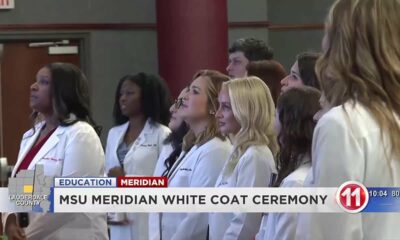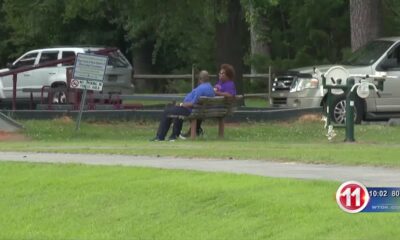Kaiser Health News
An Arm and a Leg: To Get Health Insurance, This Couple Made a Movie
Dan Weissmann
Thu, 30 Nov 2023 10:00:00 +0000
Last fall, Ellen Haun and Dru Johnston were hustling to get their health insurance sorted out for 2023. The Hollywood couple are members of SAG-AFTRA, the union representing actors and writers. Members have to earn about $26,000 a year on union projects to be eligible for union insurance.
And Haun was about $800 short.
When she couldn't book the gigs she needed, Haun, with husband Johnston's help, came up with a plan: to crowdfund enough money to make their own movie starring Haun, called “Ellen Needs Insurance.”
In this episode of “An Arm and a Leg,” host Dan Weissmann speaks with Haun and Johnston about their short film, how they were affected by the 2023 SAG-AFTRA strike, and their ongoing quest to stay insured.
Dan Weissmann
Host and producer of “An Arm and a Leg.” Previously, Dan was a staff reporter for Marketplace and Chicago's WBEZ. His work also appears on All Things Considered, Marketplace, the BBC, 99 Percent Invisible, and Reveal, from the Center for Investigative Reporting.
Credits
Emily Pisacreta
Producer
Adam Raymonda
Audio wizard
Ellen Weiss
Editor
Click to open the Transcript
Transcript: To Get Health Insurance, This Couple Made a Movie
Note: “An Arm and a Leg” uses speech-recognition software to generate transcripts, which may contain errors. Please use the transcript as a tool but check the corresponding audio before quoting the podcast.
Dan: Hey there. OK, here's something I never expected to say — I've got a funny, kind of sweet story about health insurance. OK, maybe sweet and sour. Here it is …
As we record this, it's November, which means it's open enrollment for lots of people — time to get next year's health insurance figured out, both on the Obamacare exchanges and at lots of workplaces. A year ago, Ellen Haun and her husband Dru Johnston were HUSTLING to get their health insurance set up for 2023. In the most creative possible way … by crowdfunding a creative project. They posted a video of course.
Ellen: Hi, I'm Ellen, and I need health insurance.
Dru: And I'm Dru, and I also need health insurance.
Dan: Ellen and Dru work in Hollywood — acting and writing — and folks in that industry get their insurance through the unions. But only if they've racked up enough wages for union work over a 12-month period. They'd been on Ellen's insurance through the actors' union, SAG. But last fall, as they explained in their crowdfunding video, that union insurance wasn't looking like a sure thing for the coming year.
Dru: Right now, Ellen is $804 short. So we're making a short film.
Ellen: And that short film is called “Ellen Needs Insurance.”
Dan: The video outlined their plan: to employ not just Ellen but other actors who also needed a little help getting over the finish line to qualify.
Dru: Also, which brings up the next point, are you an actor that's close to hitting your health insurance? Then please get in touch.
Ellen: Yes, we want to cast you. We want you to have insurance.
Dru: And if we raise more money than our goal, we will use all of that only
towards casting more actors and getting them insurance.
Ellen: We'll add parts. We don't care.
Dru: Yeah, this isn't Shakespeare. This is a script we wrote. We'll add parts.
Ellen: We can … We'll make them up.
Dan: That was a year ago. And spoiler: They did make the film. Of course now they need insurance for 2024. And Ellen's union spent a lot of 2023 on strike, which has narrowed down the opportunities to earn that insurance again. So… I wanted to talk with them!
[“An Arm and a Leg” theme music plays.]
This is “An Arm and a Leg” — a show about why health care costs so freaking much, and what we can maybe do about it. I'm Dan Weissmann. I'm a reporter, and I like a challenge.
So the job we've picked here is to take one of the most enraging, terrifying, depressing parts of American life, and bring you something entertaining, empowering and useful.
[“An Arm and a Leg” theme music ends.]
Ellen and Dru met at a wedding.
Ellen: I was friends with the bride and Drew was friends with the groom. And at the bachelorette party, Emily had been, like, talking about all the single guys that were going to be at the wedding, but she had forgot to include Dru on that list. So I was like, just, I was like, why is this guy talking to me so much? He's probably got a girlfriend somewhere.
Dru: Turns out I didn't. And then, uh, we ended up, uh, starting to date almost immediately after that wedding.
Dan: By then, Ellen was earning enough as an actor to qualify for health insurance, starting with an ad for Xfinity Internet and a recurring role as a law student on “How to Get Away with Murder.”
Viola Davis: Ms. Chapin, can you tell us what the Fifth Amendment is?
Ellen: The Fifth Amendment? Um, right.
It, um, assures your right to protection from self incrimination.
Viola Davis: Are you asking me?
Ellen: No, that's my answer.
Viola Davis: And it's a correct one.
Dan: Getting that insurance was a big professional milestone. More than 85 percent of SAG members do not book enough union work to qualify– it takes about 26 thousand dollars across a one-year period. (And, you know, of course most actors, Ellen included, pick up other work on the side, or even hold down a day job.) For most of the last few years, Ellen had no worries about making enough money to qualify for insurance. She'd been getting paid for a commercial that ran and ran, because it was so terrific. You may have seen it. Even I have seen it … and I kinda never watch TV. Ellen plays BOTH parts in it. She's call center employee
Claire in Phoenix: This is Claire in Phoenix, can I help you?
Dan: And she's a woman who's dialed in for customer support.
Ellen as customer: Yes.
Claire in Phoenix: Great.
Ellen as customer: Correct.
Claire in Phoenix: Ma'am. This isn't an automated computer.
Ellen as customer: Operator?
Claire in Phoenix: Ma'am? I'm here. I'm live.
Ellen as customer: Wait, you're real?
Claire in Phoenix: Yeah! With Discover Card, you can talk to a real person.
Dan: Ellen had been getting a “holding fee” — to keep her from auditioning for commercials for competitors.
Ellen: And I kind of knew in the back of my mind that like, okay, eventually this holding fee is going to go away because this commercial isn't running anymore.
Dan: And then last June, she got the call.
Ellen: My agent was like, Hey, they're releasing you from the holds. Uh, you're not getting that payment. You, um, you're free to audition for other commercials.
And I was like, okay, but what about that health insurance?
Dan: This was in June. She needed to make another 6 thousand dollars, by the end of December, to keep her insurance.
Ellen: And I thought, okay, I've got half the year. Like that's just booking like one other commercial.
Dan: But that wasn't a sure thing. She'd done it for years and years, but she wanted to hedge her bets. She experimented with working as an extra.
Ellen: And I was getting like, pretty consistent work, but also background work does not pay very well.
Dan: $187 a day. More if there's overtime, but still. It's not that it's not that much, especially if you're trying to chip away at like a 6,000 balance.
I was like, I don't know if I'm going to make this, um, I knew that it was definitely going to be down to the wire. So that's when I was like, you know what, maybe we should think about making a movie about this.
Dan: Actually, this was an idea that had kind of been on Dru's shelf for a few years. As a comedy writer for a TV talk show, Dru had gotten his insurance from the screenwriter's union, the WGA. And then in 2018 the show got canceled. Lucky for Drew, he was married to Ellen by then, so they put him on her SAG insurance. And then after that saga had ended, he had a fun idea.
Dru: I was like, oh, you know what I should have done is I should have just made a web series called, “Dru Needs Insurance.” And then I was like, well, it's too late. I guess that's an idea that I'm never going to have to do. And then flash forward.
Dan: They're in the same boat! all over again.
Except now, it's Ellen who's short, and nothing to fall back on. I asked if they remembered the day when they decided to try making the film. Dru was like, …
Dru: It was in the OBGYN's office.
Dan: Yeah. They were pregnant! This was the first doctor visit.
Dru: We had gone to the ultrasound. We saw the baby. We heard the heartbeat. We were like, well, that we were having the baby. It's coming.
Dan: Now they were gonna see the doctor, talk about next steps.
Dru: And we had about 20 minutes in that waiting room, just sitting there kind of going like, okay, our life's gonna change.
We got to make some, some choices, or we got to, like, figure out, like, what room are we going to use? All that stuff. But also in the middle of that, we were like, oh, also our health insurance is going … is set to run out.
Dan: Actually, it was going to run out exactly one month before the baby's due date.
Dru: And I was like, well, shit, we need that health insurance. Um, and, and that's when Ellen said, I think I need to make a movie and we need to do that.
Dan: So they did! They banged out a script — and brought a friend's production company on board. (The union doesn't let you just pay yourself directly.) Which brings us to the point in the story when they made that crowdfunding video
[Bouncy music plays in the background.]
Dru: It's a comedy about an actress named Ellen, and the things she does to get insurance.
Ellen: Things like begging my agent for a job, praying to the gods for a surprise residual check, and even background work.
Also, the movie's just about how hard it is to navigate insurance in this country.
[Bouncy music ends.
Dan: How'd it come out? That's next.
This episode of “An Arm and a Leg” is produced in partnership with KFF Health News. That's a nonprofit newsroom covering health care in America. Their journalism is terrific– wins all kinds of awards every year– and I'm honored to work with them.
Dan: So, Ellen and Dru did raise the money: more than 33 thousand dollars. They actually did beat their goal. The movie is delightfully meta. It starts with Ellen-the-character in her kitchen in the middle of a conversation with her best friend …
Best Friend: Why can't you just pay the difference?
Ellen: Oh yeah, I tried. But I called and they told me that's not allowed.
Best Friend: I thought that was the whole thing about health insurance in this country. You have to pay for it.
Ellen: Apparently, not when you want to. If I want to keep my health insurance, I have to book another SAG job by the end of the year.
Best Friend: Couldn't you cast yourself in something?
Ellen: Like in what, my own movie? Yeah. I mean, I'd have to get funding,
write a script, hire a production team, get a payroll company, …
Dan: So just like the real Ellen did, movie-Ellen decides to go all out to book another commercial. And if you ever thought it might be fun to take a crack at a career in acting, the audition scene — with Ellen and a casting director — that might dissuade you.
Casting director: Alright, we'll start on action and, uh, remember, this determines whether or not you can see a doctor in the next year.
Dan: Soon, we see Ellen looking up COBRA — which you may have looked up yourself, like if you ever left a job without your next gig — and your next insurance — lined up.
COBRA pitch: Losing your health insurance?
Don't worry. It happens all the time. Cobra is here for you. …
Dan: And if you've looked at it, you know: COBRA is EXPENSIVE. Like, average employer coverage for a family costs more than 20 thousand dollars a year. So that's the price range for COBRA.
COBRA pitch: The fact that it's named after a deadly and venomous snake is just part of the fun, and has nothing to do with the fact that it feels like death. You made less money, and now you have to pay more.
Dan: On her agent's advice, Ellen tries background work, another case of art imitating life. And, in a scene that really highlights some of the peculiarities about how all of this works, she debriefs with her friend, over drinks at a bar.
Best Friend: How is it?
Ellen: It's not as bad as I thought, but it does not pay very well. You get a
lot more if you have a line.
Dan: And suddenly, another patron in the bar leans into the conversation… Bar patron: Excuse me, did you say you get more money if you have a line?
Ellen: Yeah.
Bar patron: Got it.
Dan: And another patron. Bar patron: Just one line?
Ellen: Yeah.
You get more if you have more than five lines, too.
Bar patron: Wow. Wow.
Dan:Now it's everybody in the bar.
Bar patrons: Wow. Wow. Wow. Wow. Wow. Wow. Wow. Wow. Wow. Wow.
Dan: The bit about a pay bump is real, of course. Including the bump for more-than-five-lines. And just to expand on that for a minute here – Dru experienced the downside of that rule — ridiculously, painfully — when he did a one-shot appearance on Orange Is the New Black. It was a big meaty scene, but somehow wasn't more than five lines.
Dru: I was a lawyer and every line was about a half of a page of just legalese
Dru as Lawyer: based on copious witness testimony, the U. S. attorney has charged you and four others
[DUCKS UNDER: with inciting the riot. They allege that you created and maintained a secret riot bunker, and there's also evidence that directly implicates you in the kidnapping and false imprisonment of Officer Desmond Piscatella…]
Dan: But that's how a “line” gets defined in this situation: As long as nobody interrupts you, a monologue is just one line. A role with five lines or less gets called an “under-five”
Dru: And I was like, this is an under five? I was like, okay, well, there we go. I'll just lecture for two pages.
Dru as Lawyer: I've negotiated a plea deal for you. If you admit to the riot charges, they're willing to drop everything else. This is very good.
Dan: We have still not gotten to the end of Dru's first line in this scene Dru as Lawyer: It'll garner you the shortest possible sentence.
Dru as Lawyer: Do you understand?
Dan: Back in the film, the Ellen character is still freaking out when she shows up for a doctor's appointment.
Dr Receptionist: Has your insurance changed?
Ellen: No, but it might soon, so I wanted to make sure that you all would still take it.
Dr. Receptionist: Well, we take most insurances, so I'm sure we'll be fine.
Ellen: Great. Um, I was looking on the California Insurance Exchange. Dr Receptionist: Uh, no.
Ellen: Excuse me?
Dr. Receptionist: No, we, we don't take that.
Dan: And in the doctor's office– in another echo of Ellen and Dru's story– Ellen-the-character gets an ultrasound.
Ellen: Congratulations.
Dan: And she flashes back to the first scene, with her friend…
Best Friend: Couldn't you cast yourself in something?
Ellen: Like in what? My own movie? (echos) My own movie?
Dan: And of course, that's where she decides. She's gonna do this. On her way out, she tells the receptionist…
Ellen: My insurance is not going to change. You can count on it.
Dr. Receptionist: Um, okay.
Dan: When I saw the movie, I did not know that Ellen Haun had been pregnant when they made it.
Dru: We never brought it up in crowdfunding. But then when we were making the movie, we were like, let's just use real life. Not only was it real, it felt like the easiest way to explain it.
Dan: They shot the movie over three days in December 2022. Making this film on $33,000 and change was a feat on its own. They paid 15 actors, and a crew. There was a location to rent, and equipment…
Ellen: You've got to pay for food to feed your cast and crew. And especially, you know, everyone is kind of working a little bit under their rate so you want to buy them good food.
Dan: You've heard some of the results. I won't spoil the rest. It's a very-enjoyable 13 minutes. We'll have a link wherever you're listening to this. With the movie wrapped by New Years, Ellen qualified for her insurance, so she was on it when their baby Bruce was born a few weeks early.
Ellen: We spent three weeks in the NICU and the entire time that we were in the hospital with him, we just kept saying, I'm so glad we have insurance. I'm so glad we have insurance. I'm so glad we have insurance.
Dan: Just a few weeks after Bruce was born, Dru's union– the Writer's Guild– went on strike. Then Ellen's union went on strike too.
Ellen: We took Bruce to his very first picket when he was like two months old. And I've been going, like, about, once a week to, to picket with him. So everybody knows him at
the Disney Picket location. He's a little union baby.
Dru: We say the joke, he went straight from labor to labor action.
Dan: No joke, though: the SAG strike meant there was less work for actors in 2023– fewer chances to earn money and qualify for insurance. The health plan extended a grace period to keep folks from getting cut off, and a new law in California lets workers who are on strike get subsidized insurance from the state's Obamacare exchange. Meanwhile, Ellen managed to book another commercial — only TV shows and movies were targeted by the strike, not ads — so their family is set for next year too.
It's a happy ending … for now.
But this seems like an exhausting merry-go-round to stay on for the rest of your life. I asked Ellen and Dru how they felt about it.
Ellen: So something that has been nice about the strike has been talking to a bunch of our friends about how hard it's gotten over the last several years to make a living doing this.
I was like in my late twenties when I got the SAG health insurance for the first time. I thought, like, “Great.” Like, “this is it.”
Dan: That was almost ten years ago. But somehow getting consistent work actually got harder over time. And that felt personal.
Ellen: It was like feeling, like, emotionally, like there's something wrong with me that I am not making the amount of money that I made earlier in my career. And so, honestly, that has been a nice part of the strike has been realizing that, hey, this is happening to all of us. It's not just happening to me. It's really hard.
Dan: But it's not just hard for actors and writers.
Dru: My brother works in tech. Right. And like, I think the nature of employment, across many industries has changed. And like, there isn't really that same job security that there used to be when, like, my parents were coming up.
Dan: Dru thinks back to the time, years ago, when he first quit his day job, to write and perform full-time. It was touch and go at first. Like, week to week, it could feel precarious.
Dru: I had a kind of a down week and I was like, maybe it's time to get a real day job like my brother. And right that week, he got laid off. He's found another job, he's figured it out, but it was that moment where I was like, oh, there's no job that you can just get and be like, now I'm set with health insurance. So that's a long answer to say, I don't think we're leaving the entertainment industry anytime soon.
Ellen: Yeah, we've kind of put all of our chips on the table.
Dan: And like Dru said: Fewer of us these days have jobs where we don't have to worry about where our health insurance is coming from, or if it's gonna be any good. I mean, if more of us had that kind of security, I would literally never have started making this show. There would be no reason to make it. But of course, five years in, I do not expect to run out of material.
As we publish this episode, we've also just put out an installment of our First Aid Kit newsletter, this one sums up and updates all our best advice about how to pick the least-crappy health insurance for you.
I've learned a lot in five years. And we're able to share what we've learned because you've been supporting us. And if you can, this is the absolute best moment to pitch in, because right now, every dollar you give — up to a thousand dollars per person! — get matched. Thanks to NewsMatch from the Institute for Nonprofit News, every dollar you give us counts for double. The place to go is arm and a leg show, dot com, slash support. That's https://armandalegshow.com/support/.
We'll be back in three weeks with part one of a big investigative story we've been working on … pretty much all year. Talk about learning a ton. It's been a wild ride. We've been able to do that — and we'll be able to share the results with you– because of your support, and I am super-thankful. I'll leave you with that address one more time: arm and a leg show dot com, slash, support. Thanks! I'll catch you in three weeks. Till then, take care of yourself.
This episode of “An Arm and a Leg” was produced by Emily Pisacreta and me, Dan Weissman and edited by Ellen Weiss.
Daisy Rosario is our consulting managing producer.
Adam Raymonda is our audio wizard.
Our music is by Dave Winer and Blue Dot Sessions.
Gabrielle Healy is our managing editor for audience. She edits the First Aid Kit Newsletter.
Bea Bosco is our consulting director of operations.
Sarah Ballema is our operations manager.
“An Arm and a Leg” is produced in partnership with KFF Health News — formerly known as Kaiser Health News. That's a national newsroom producing in-depth journalism about healthcare in America, and a core program at KFF — an independent source of health policy research, polling, and journalism. You can learn more about KFF Health News at: https://armandalegshow.com/about-x/partners-and-supporters/kaiserhealthnews/
Zach Dyer is senior audio producer at KFF Health News. He is editorial liaison to this show.
Big thanks to the Institute for Nonprofit News for serving as our fiscal sponsor, allowing us to accept tax-exempt donations. You can learn more about INN at INN.org
And now for one of my favorite parts of the gig … giving a shout out to some of the people who've come aboard to support this show in the last few weeks. Thanks at this time to our supporters (Dan lists donors.) Thank you so much!
“An Arm and a Leg” is a co-production of KFF Health News and Public Road Productions.
To keep in touch with “An Arm and a Leg,” subscribe to the newsletter. You can also follow the show on Facebook and X, formerly known as Twitter. And if you've got stories to tell about the health care system, the producers would love to hear from you.
To hear all KFF Health News podcasts, click here.
And subscribe to “An Arm and a Leg” on Spotify, Apple Podcasts, Pocket Casts, or wherever you listen to podcasts.
——————————
By: Dan Weissmann
Title: An Arm and a Leg: To Get Health Insurance, This Couple Made a Movie
Sourced From: kffhealthnews.org/news/podcast/health-insurance-actors-union-couple-movie/
Published Date: Thu, 30 Nov 2023 10:00:00 +0000
Did you miss our previous article…
https://www.biloxinewsevents.com/medicare-advantage-increasingly-popular-with-seniors-but-not-hospitals-and-doctors/
Kaiser Health News
Medical Residents Are Increasingly Avoiding States With Abortion Restrictions
Julie Rovner, KFF Health News and Rachana Pradhan
Thu, 09 May 2024 12:01:00 +0000
Isabella Rosario Blum was wrapping up medical school and considering residency programs to become a family practice physician when she got some frank advice: If she wanted to be trained to provide abortions, she shouldn't stay in Arizona.
Blum turned to programs mostly in states where abortion access — and, by extension, abortion training — is likely to remain protected, like California, Colorado, and New Mexico. Arizona has enacted a law banning most abortions after 15 weeks.
“I would really like to have all the training possible,” she said, “so of course that would have still been a limitation.”
In June, she will start her residency at Swedish Cherry Hill hospital in Seattle.
According to new statistics from the Association of American Medical Colleges, for the second year in a row, students graduating from U.S. medical schools were less likely to apply this year for residency positions in states with abortion bans and other significant abortion restrictions.
Since the Supreme Court in 2022 overturned the constitutional right to an abortion, state fights over abortion access have created plenty of uncertainty for pregnant patients and their doctors. But that uncertainty has also bled into the world of medical education, forcing some new doctors to factor state abortion laws into their decisions about where to begin their careers.
Fourteen states, primarily in the Midwest and South, have banned nearly all abortions. The new analysis by the AAMC — a preliminary copy of which was exclusively reviewed by KFF Health News before its public release — found that the number of applicants to residency programs in states with near-total abortion bans declined by 4.2%, compared with a 0.6% drop in states where abortion remains legal.
Notably, the AAMC's findings illuminate the broader problems abortion bans can create for a state's medical community, particularly in an era of provider shortages: The organization tracked a larger decrease in interest in residencies in states with abortion restrictions not only among those in specialties most likely to treat pregnant patients, like OB-GYNs and emergency room doctors, but also among aspiring doctors in other specialties.
“It should be concerning for states with severe restrictions on reproductive rights that so many new physicians — across specialties — are choosing to apply to other states for training instead,” wrote Atul Grover, executive director of the AAMC's Research and Action Institute.
The AAMC analysis found the number of applicants to OB-GYN residency programs in abortion ban states dropped by 6.7%, compared with a 0.4% increase in states where abortion remains legal. For internal medicine, the drop observed in abortion ban states was over five times as much as in states where abortion is legal.
In its analysis, the AAMC said an ongoing decline in interest in ban states among new doctors ultimately “may negatively affect access to care in those states.”
Jack Resneck Jr., immediate past president of the American Medical Association, said the data demonstrates yet another consequence of the post-Roe v. Wade era.
The AAMC analysis notes that even in states with abortion bans, residency programs are filling their positions — mostly because there are more graduating medical students in the U.S. and abroad than there are residency slots.
Still, Resneck said, “we're extraordinarily worried.” For example, physicians without adequate abortion training may not be able to manage miscarriages, ectopic pregnancies, or potential complications such as infection or hemorrhaging that could stem from pregnancy loss.
Those who work with students and residents say their observations support the AAMC's findings. “People don't want to go to a place where evidence-based practice and human rights in general are curtailed,” said Beverly Gray, an associate professor of obstetrics and gynecology at Duke University School of Medicine.
Abortion in North Carolina is banned in nearly all cases after 12 weeks. Women who experience unexpected complications or discover their baby has potentially fatal birth defects later in pregnancy may not be able to receive care there.
Gray said she worries that even though Duke is a highly sought training destination for medical residents, the abortion ban “impacts whether we have the best and brightest coming to North Carolina.”
Rohini Kousalya Siva will start her obstetrics and gynecology residency at MedStar Washington Hospital Center in Washington, D.C., this year. She said she did not consider programs in states that have banned or severely restricted abortion, applying instead to programs in Maryland, New Hampshire, New York, and Washington, D.C.
“We're physicians,” said Kousalya Siva, who attended medical school in Virginia and was previously president of the American Medical Student Association. “We're supposed to be giving the best evidence-based care to our patients, and we can't do that if we haven't been given abortion training.”
Another consideration: Most graduating medical students are in their 20s, “the age when people are starting to think about putting down roots and starting families,” said Gray, who added that she is noticing many more students ask about politics during their residency interviews.
And because most young doctors make their careers in the state where they do their residencies, “people don't feel safe potentially having their own pregnancies living in those states” with severe restrictions, said Debra Stulberg, chair of the Department of Family Medicine at the University of Chicago.
Stulberg and others worry that this self-selection away from states with abortion restrictions will exacerbate the shortages of physicians in rural and underserved areas.
“The geographic misalignment between where the needs are and where people are choosing to go is really problematic,” she said. “We don't need people further concentrating in urban areas where there's already good access.”
After attending medical school in Tennessee, which has adopted one of the most sweeping abortion bans in the nation, Hannah Light-Olson will start her OB-GYN residency at the University of California-San Francisco this summer.
It was not an easy decision, she said. “I feel some guilt and sadness leaving a situation where I feel like I could be of some help,” she said. “I feel deeply indebted to the program that trained me, and to the patients of Tennessee.”
Light-Olson said some of her fellow students applied to programs in abortion ban states “because they think we need pro-choice providers in restrictive states now more than ever.” In fact, she said, she also applied to programs in ban states when she was confident the program had a way to provide abortion training.
“I felt like there was no perfect, 100% guarantee; we've seen how fast things can change,” she said. “I don't feel particularly confident that California and New York aren't going to be under threat, too.”
As a condition of a scholarship she received for medical school, Blum said, she will have to return to Arizona to practice, and it is unclear what abortion access will look like then. But she is worried about long-term impacts.
“Residents, if they can't get the training in the state, then they're probably less likely to settle down and work in the state as well,” she said.
——————————
By: Julie Rovner, KFF Health News and Rachana Pradhan
Title: Medical Residents Are Increasingly Avoiding States With Abortion Restrictions
Sourced From: kffhealthnews.org/news/article/medical-students-residents-spurning-abortion-ban-states/
Published Date: Thu, 09 May 2024 12:01:00 +0000
Did you miss our previous article…
https://www.biloxinewsevents.com/paid-sick-leave-sticks-after-many-pandemic-protections-vanish/
Kaiser Health News
Paid Sick Leave Sticks After Many Pandemic Protections Vanish
Zach Dyer
Thu, 09 May 2024 09:00:00 +0000
Bill Thompson's wife had never seen him smile with confidence. For the first 20 years of their relationship, an infection in his mouth robbed him of teeth, one by one.
“I didn't have any teeth to smile with,” the 53-year-old of Independence, Missouri, said.
Thompson said he dealt with throbbing toothaches and painful swelling in his face from abscesses for years working as a cook at Burger King. He desperately needed to see a dentist but said he couldn't afford to take time off without pay. Missouri is one of many states that do not require employers to provide paid sick leave.
So, Thompson would swallow Tylenol and push through the pain as he worked over the hot grill.
“Either we go to work, have a paycheck,” Thompson said. “Or we take care of ourselves. We can't take care of ourselves because, well, this vicious circle that we're stuck in.”
In a nation that was sharply divided about government health mandates during the covid-19 pandemic, the public has been warming to the idea of government rules providing for paid sick leave.
Before the pandemic, 10 states and the District of Columbia had laws requiring employers to provide paid sick leave. Since then, Colorado, New York, New Mexico, Illinois, and Minnesota have passed laws offering some kind of paid time off for illness. Oregon and California expanded previous paid leave laws. In Missouri, Alaska, and Nebraska, advocates are pushing to put the issue on the ballot this fall.
The U.S. is one of nine countries that do not guarantee paid sick leave, according to data compiled by the World Policy Analysis Center.
In response to the pandemic, Congress passed the Emergency Paid Sick Leave and Emergency Family and Medical Leave Expansion acts. These temporary measures allowed employees to take up to two weeks of paid sick leave for covid-related illness and caregiving. But the provisions expired in 2021.
“When the pandemic hit, we finally saw some real political will to solve the problem of not having federal paid sick leave,” said economist Hilary Wething.
Wething co-authored a recent Economic Policy Institute report on the state of sick leave in the United States. It found that more than half, 61%, of the lowest-paid workers can't get time off for an illness.
“I was really surprised by how quickly losing pay — because you're sick — can translate into immediate and devastating cuts to a family's household budget,” she said.
Wething noted that the lost wages of even a day or two can be equivalent to a month's worth of gasoline a worker would need to get to their job, or the choice between paying an electric bill or buying food. Wething said showing up to work sick poses a risk to co-workers and customers alike. Low-paying jobs that often lack paid sick leave — like cashiers, nail technicians, home health aides, and fast-food workers — involve lots of face-to-face interactions.
“So paid sick leave is about both protecting the public health of a community and providing the workers the economic security that they desperately need when they need to take time away from work,” she said.
The National Federation of Independent Business has opposed mandatory sick leave rules at the state level, arguing that workplaces should have the flexibility to work something out with their employees when they get sick. The group said the cost of paying workers for time off, extra paperwork, and lost productivity burdens small employers.
According to a report by the National Bureau of Economic Research, once these mandates go into effect, employees take, on average, two more sick days a year than before a law took effect.
Illinois' paid time off rules went into effect this year. Lauren Pattan is co-owner of the Old Bakery Beer Co. there. Before this year, the craft brewery did not offer paid time off for its hourly employees. Pattan said she supports Illinois' new law but she has to figure out how to pay for it.
“We really try to be respectful of our employees and be a good place to work, and at the same time we get worried about not being able to afford things,” she said.
That could mean customers have to pay more to cover the cost, Pattan said.
As for Bill Thompson, he wrote an op-ed for the Kansas City Star newspaper about his dental struggles.
“Despite working nearly 40 hours a week, many of my co-workers are homeless,” he wrote. “Without health care, none of us can afford a doctor or a dentist.”
That op-ed generated attention locally and, in 2018, a dentist in his community donated his time and labor to remove Thompson's remaining teeth and replace them with dentures. This allowed his mouth to recover from the infections he'd been dealing with for years. Today, Thompson has a new smile and a job — with paid sick leave — working in food service at a hotel.
In his free time, he's been collecting signatures to put an initiative on the November ballot that would guarantee at least five days of earned paid sick leave a year for Missouri workers. Organizers behind the petition said they have enough signatures to take it before the voters.
——————————
By: Zach Dyer
Title: Paid Sick Leave Sticks After Many Pandemic Protections Vanish
Sourced From: kffhealthnews.org/news/article/paid-sick-leave-post-pandemic-state-laws/
Published Date: Thu, 09 May 2024 09:00:00 +0000
Did you miss our previous article…
https://www.biloxinewsevents.com/forget-ringing-the-button-for-the-nurse-patients-now-stay-connected-by-wearing-one/
Kaiser Health News
Forget Ringing the Button for the Nurse. Patients Now Stay Connected by Wearing One.
Phil Galewitz, KFF Health News
Wed, 08 May 2024 09:00:00 +0000
HOUSTON — Patients admitted to Houston Methodist Hospital get a monitoring device about the size of a half-dollar affixed to their chest — and an unwitting role in the expanding use of artificial intelligence in health care.
The slender, battery-powered gadget, called a BioButton, records vital signs including heart and breathing rates, then wirelessly sends the readings to nurses sitting in a 24-hour control room elsewhere in the hospital or in their homes. The device's software uses AI to analyze the voluminous data and detect signs a patient's condition is deteriorating.
Hospital officials say the BioButton has improved care and reduced the workload of bedside nurses since its rollout last year.
“Because we catch things earlier, patients are doing better, as we don't have to wait for the bedside team to notice if something is going wrong,” said Sarah Pletcher, system vice president at Houston Methodist.
But some nurses fear the technology could wind up replacing them rather than supporting them — and harming patients. Houston Methodist, one of dozens of U.S. hospitals to employ the device, is the first to use the BioButton to monitor all patients except those in intensive care, Pletcher said.
“The hype around a lot of these devices is they provide care at scale for less labor costs,” said Michelle Mahon, a registered nurse and an assistant director of National Nurses United, the profession's largest U.S. union. “This is a trend that we find disturbing,” she said.
The rollout of BioButton is among the latest examples of hospitals deploying technology to improve efficiency and address a decades-old nursing shortage. But that transition has raised its own concerns, including about the device's use of AI; polls show the public is wary of health providers relying on it for patient care.
In December 2022 the FDA cleared the BioButton for use in adult patients who are not in critical care. It is one of many AI tools now used by hospitals for tasks like reading diagnostic imaging results.
In 2023, President Joe Biden directed the Department of Health and Human Services to develop a plan to regulate AI in hospitals, including by collecting reports of patients harmed by its use.
The leader of BioIntelliSense, which developed the BioButton, said its device is a huge advance compared with nurses walking into a room every few hours to measure vital signs. “With AI, you now move from ‘I wonder why this patient crashed' to ‘I can see this crash coming before it happens and intervene appropriately,'” said James Mault, CEO of the Golden, Colorado-based company.
The BioButton stays on the skin with an adhesive, is waterproof, and has up to a 30-day battery life. The company says the device — which allows providers to quickly notice deteriorating health by recording more than 1,000 measurements a day per patient — has been used on more than 80,000 hospital patients nationwide in the past year.
Hospitals pay BioIntelliSense an annual subscription fee for the devices and software.
Houston Methodist officials would not reveal how much the hospital pays for the technology, though Pletcher said it equates to less than a cup of coffee a day per patient.
For a hospital system that treats thousands of patients at a time — Houston Methodist has 2,653 non-ICU beds at its eight Houston-area hospitals — such an investment could still translate to millions of dollars a year.
Hospital officials say they have not made any changes in nurse staffing and have no plans to because of implementing the BioButton.
Inside the hospital's control center for virtual monitoring on a recent morning, about 15 nurses and technicians dressed in scrubs sat in front of large monitors showing the health status of hundreds of patients they were assigned to monitor.
A red checkmark next to a patient's name signaled the AI software had found readings trending outside normal. Staff members could click into a patient's medical record, showing patients' vital signs over time and other medical history. These virtual nurses, if you will, could contact nurses on the floor by phone or email, or even dial directly into the patient's room via video call.
Nutanben Gandhi, a technician who was watching 446 patients on her monitor that morning, said that when she gets an alert, she looks at the patient's health record to see if the anomaly can be easily explained by something in the patient's condition or if she needs to contact nurses on the patient's floor.
Oftentimes an alert can be easily dismissed. But identifying signs of deteriorating health can be tough, said Steve Klahn, Houston Methodist's clinical director of virtual medicine.
“We are looking for a needle in a haystack,” he said.
Donald Eustes, 65, was admitted to Houston Methodist in March for prostate cancer treatment and has since been treated for a stroke. He is happy to wear the BioButton.
“You never know what can happen here, and having an extra set of eyes looking at you is a good thing,” he said from his hospital bed. After being told the device uses AI, the Montgomery, Texas, man said he has no problem with its helping his clinical team. “This sounds like a good use of artificial intelligence.”
Patients and nurses alike benefit from remote monitoring like the BioButton, said Pletcher of Houston Methodist.
The hospital has placed small cameras and microphones inside all patient rooms enabling nurses outside to communicate with patients and perform tasks such as helping with patient admissions and discharge instructions. Patients can include family members on the remote calls with nurses or a doctor, she said.
Virtual technology frees up on-duty nurses to provide more hands-on help, such as starting an intravenous line, Pletcher said. With the BioButton, nurses can wait to take routine vital signs every eight hours instead of every four, she said.
Pletcher said the device reduces nurses' stress in monitoring patients and allows some to work more flexible hours because virtual care can be done from home rather than coming to the hospital. Ultimately it helps retain nurses, not drive them away, she said.
Sheeba Roy, a nurse manager at Houston Methodist, said some members of the nursing staff were nervous about relying on the device and not checking patients' vital signs as often themselves. But testing has shown the device provides accurate information.
“After we implemented it, the staff loves it,” Roy said.
Serena Bumpus, chief executive officer of the Texas Nurses Association, said her concern with any technology is that it can be more burdensome on nurses and take away time with patients.
“We have to be hypervigilant in ensuring that we are not leaning on this to replace the ability of nurses to critically think and assess patients and validate what this device is telling us is true,” Bumpus said.
Houston Methodist this year plans to send the BioButton home with patients so the hospital can better track their progress in the weeks after discharge, measuring the quality of their sleep and checking their gait.
“We are not going to need less nurses in health care, but we have limited resources and we have to use those as thoughtfully as we can,” Pletcher said. “Looking at projected demand and seeing the supply we have coming, we will not have enough to meet demand, so anything we can do to give time back to nurses is a good thing.”
——————————
By: Phil Galewitz, KFF Health News
Title: Forget Ringing the Button for the Nurse. Patients Now Stay Connected by Wearing One.
Sourced From: kffhealthnews.org/news/article/hospital-artificial-intelligence-patient-monitoring-biobutton-houston/
Published Date: Wed, 08 May 2024 09:00:00 +0000
Did you miss our previous article…
https://www.biloxinewsevents.com/they-were-shot-at-the-super-bowl-parade-and-might-have-bullets-in-their-bodies-forever/
-
SuperTalk FM7 days ago
Driver’s education set to become mandatory in Mississippi as bill passes
-
SuperTalk FM6 days ago
State approves $160M to expand Highway 7 to four lanes in Lafayette County
-
SuperTalk FM2 days ago
Legislation outlawing ‘squatted’ vehicles in Mississippi signed into law
-
Mississippi Today4 days ago
On this day in 1917
-
Mississippi News4 days ago
LCSO wants people aware of a scam circling the area
-
228Sports2 days ago
PRC’s Bats Come Alive Late As Blue Devils Beat Picayune To Advance To 6A South State Title Series
-
Mississippi News4 days ago
Winston Co. Sheriff’s Office investigates shooting at Dave’s Club
-
Mississippi News7 days ago
Altercation at Mississippi police department leads to officer-involved shooting





































